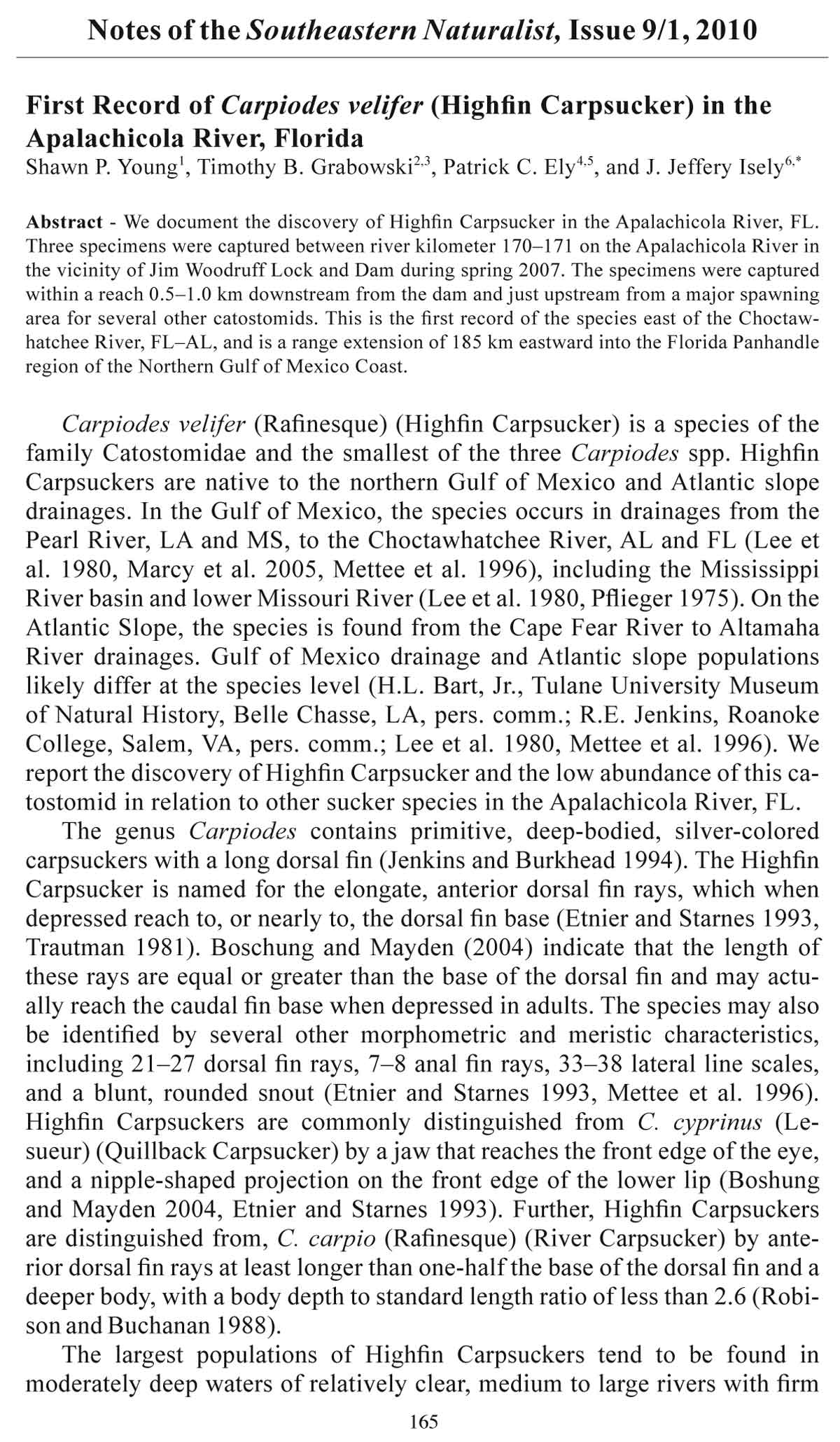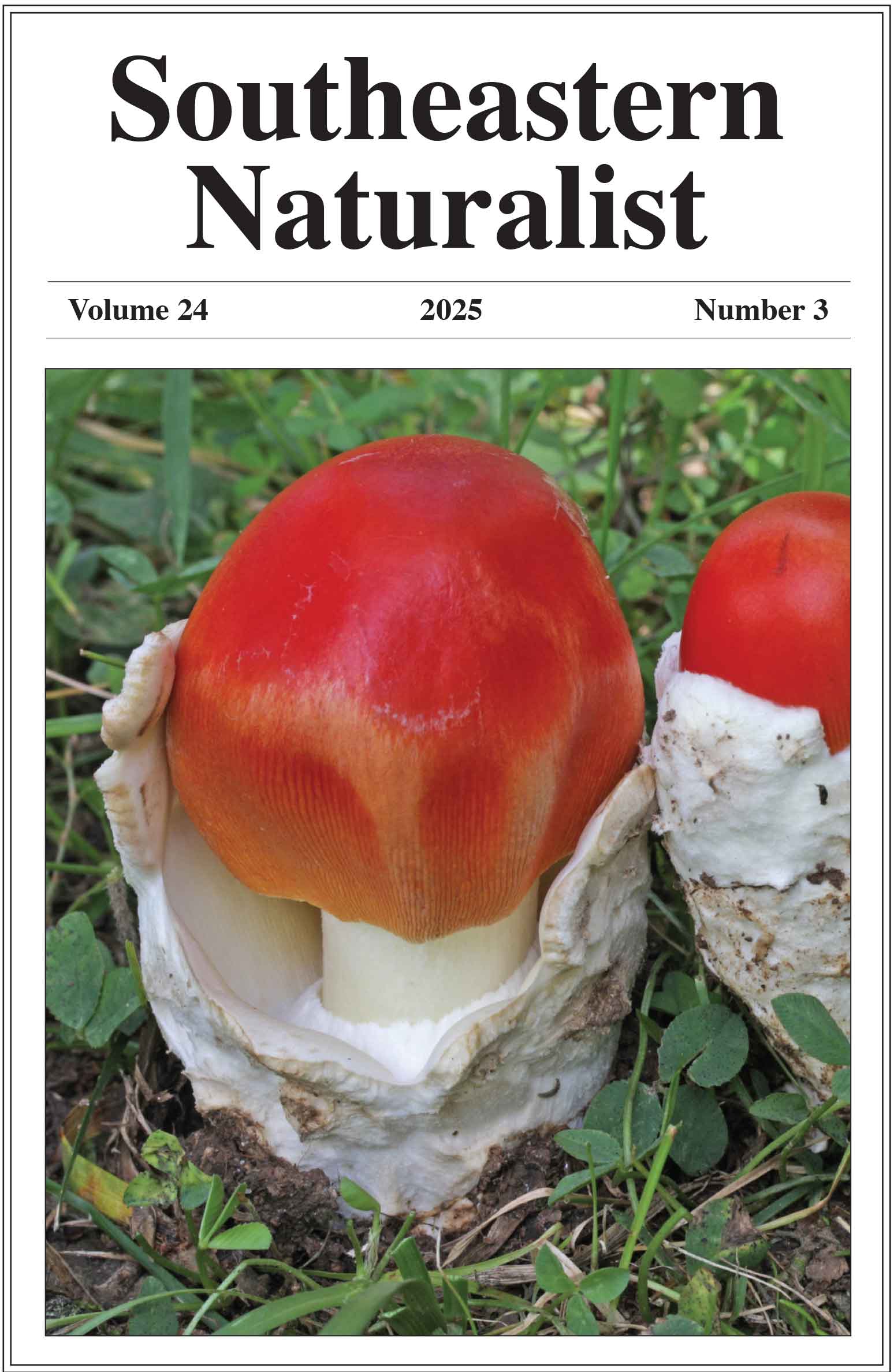2006 NORTHEASTERN NATURALIST 13(1):39–42
First Record of Carpiodes velifer (Highfin Carpsucker) in the
Apalachicola River, Florida
Shawn P. Young1, Timothy B. Grabowski2,3, Patrick C. Ely4,5, and J. Jeffery Isely6,*
Abstract - We document the discovery of Highfin Carpsucker in the Apalachicola River, FL.
Three specimens were captured between river kilometer 170–171 on the Apalachicola River in
the vicinity of Jim Woodruff Lock and Dam during spring 2007. The specimens were captured
within a reach 0.5–1.0 km downstream from the dam and just upstream from a major spawning
area for several other catostomids. This is the first record of the species east of the Choctawhatchee
River, FL–AL, and is a range extension of 185 km eastward into the Florida Panhandle
region of the Northern Gulf of Mexico Coast.
Carpiodes velifer (Rafinesque) (Highfin Carpsucker) is a species of the
family Catostomidae and the smallest of the three Carpiodes spp. Highfin
Carpsuckers are native to the northern Gulf of Mexico and Atlantic slope
drainages. In the Gulf of Mexico, the species occurs in drainages from the
Pearl River, LA and MS, to the Choctawhatchee River, AL and FL (Lee et
al. 1980, Marcy et al. 2005, Mettee et al. 1996), including the Mississippi
River basin and lower Missouri River (Lee et al. 1980, Pfl ieger 1975). On the
Atlantic Slope, the species is found from the Cape Fear River to Altamaha
River drainages. Gulf of Mexico drainage and Atlantic slope populations
likely differ at the species level (H.L. Bart, Jr., Tulane University Museum
of Natural History, Belle Chasse, LA, pers. comm.; R.E. Jenkins, Roanoke
College, Salem, VA, pers. comm.; Lee et al. 1980, Mettee et al. 1996). We
report the discovery of Highfin Carpsucker and the low abundance of this catostomid
in relation to other sucker species in the Apalachicola River, FL.
The genus Carpiodes contains primitive, deep-bodied, silver-colored
carpsuckers with a long dorsal fin (Jenkins and Burkhead 1994). The Highfin
Carpsucker is named for the elongate, anterior dorsal fin rays, which when
depressed reach to, or nearly to, the dorsal fin base (Etnier and Starnes 1993,
Trautman 1981). Boschung and Mayden (2004) indicate that the length of
these rays are equal or greater than the base of the dorsal fin and may actually
reach the caudal fin base when depressed in adults. The species may also
be identified by several other morphometric and meristic characteristics,
including 21–27 dorsal fin rays, 7–8 anal fin rays, 33–38 lateral line scales,
and a blunt, rounded snout (Etnier and Starnes 1993, Mettee et al. 1996).
Highfin Carpsuckers are commonly distinguished from C. cyprinus (Lesueur)
(Quillback Carpsucker) by a jaw that reaches the front edge of the eye,
and a nipple-shaped projection on the front edge of the lower lip (Boshung
and Mayden 2004, Etnier and Starnes 1993). Further, Highfin Carpsuckers
are distinguished from, C. carpio (Rafinesque) (River Carpsucker) by anterior
dorsal fin rays at least longer than one-half the base of the dorsal fin and a
deeper body, with a body depth to standard length ratio of less than 2.6 (Robison
and Buchanan 1988).
The largest populations of Highfin Carpsuckers tend to be found in
moderately deep waters of relatively clear, medium to large rivers with firm
Notes of the Southeastern Nat u ral ist, Issue 9/1, 2010
165
166 Southeastern Naturalist Notes Vol. 9, No. 1
substrates of gravel (Etnier and Starnes 1993, Pfl ieger 1997, Robison and
Buchanan 1988). However, this species may also inhabit lowland overfl ow
ponds, oxbows, and, less frequently, reservoirs (Etnier and Starnes 1993,
Trautman 1981). Highfin Carpsucker is considered to be the member of
Carpiodes least tolerant to increased turbidity, siltation, and impoundment
(Etnier and Starnes 1993, Pfl ieger 1997, Robison and Buchanan 1988). This
sensitivity is a presumed factor in the observed decline of the species throughout
its range. Highfin Carpsucker was once the most abundant carpsucker
species in Illinois and is now considered rare in the state (Smith 2002). Highfin Carpsucker is currently deemed a species of special concern in Illinois,
Pennsylvania, North Carolina, South Carolina, Kansas, and Missouri.
Our discovery of the species in the Apalachicola River is the first record of
a Gulf Slope population east of the Choctawhatchee River, and represents a
range extension of 185 km eastward into the Florida Panhandle region of the
Northern Gulf of Mexico Coast. Three adult Highfin Carpsuckers were captured
using a boat-mounted electrofisher on 27 February, 5 March, and 1 April
2007. All individuals were captured over gravel in shallow water with swift
current immediately below the Jim Woodruff Lock and Dam (JWLD) tailrace
and upriver of a major spawning area for several other catostomids (Fig. 1).
Figure 1. Location of study site within the southeastern United States and within the Apalachicola
River Basin. Schematic represents the study site and of Jim Woodruff Lock and Dam. Solid
arrows indicate permanent stable fl ow, and dashed arrows indicate intermittent variable fl ow.
Solid star denotes Highfin Carpsucker capture site. Textured circles indicate location of gravel
bars where other catostomid species were captured.
2010 Southeastern Naturalist Notes 167
Water temperatures on capture dates ranged from 14–19.5 °C. The specimens
were photographed, fin-clips were collected from each for genetic analysis, and
one voucher specimen was preserved. Identification of voucher specimen was
verified by Dr. Wayne Starnes, North Carolina Museum of Natural Sciences,
Raleigh, NC, and the preserved specimen was deposited at the North Carolina
Museum of Natural Sciences, Raleigh, NC, catalog number NCSM45841
(Fig. 2a). Dr. Henry L. Bart, Jr., Tulane University Museum of Natural History,
Belle Chasse, LA, further verified identification using genetic techniques.
Figure 2. (a) Lateral view of C. velifer (Highfin Carpsucker) specimen captured below Jim
Woodruff Lock and Dam, Apalachicola River. (b) Ventral view of jaw and snout for C. velifer
and C. cyprinus (Quillback Carpsucker) specimens from the Apalachicola River.
168 Southeastern Naturalist Notes Vol. 9, No. 1
In the field, Highfin Carpsuckers were identified and distinguished from
Quillback by comparing head, snout, and lip form, and the presence of a
nipple-like projection on lower lip (Fig. 2b.). Total lengths and weights
of the three specimens were 340 mm and 735 g, 353 mm and 808 g, and
350 mm and 550 g. We counted 35 lateral line scales, 18 caudal peduncle
scales, 24 dorsal fin rays, 8 anal fin rays, and 16 pectoral fin rays for each.
The catalogued specimen’s lateral line and caudal peduncle scale counts,
and dorsal, anal, and pectoral fin ray counts conform to species descriptions.
Also, the body depth to standard length ratio was less than 2.6, and a
nipple-like projection was present on lower lip. However, the anterior dorsal
fin rays were shorter than described by Boschung and Mayden (2004) for
Highfin Carpsucker, but still longer than one-half length of dorsal fin base
as described for River Carpsuckers (Robison and Buchanan 1988). The age
of all three Highfin Carpsuckers was estimated at 5–7 years from scale annuli.
The age estimate from otolith cross-sections from one specimen agreed
with the estimate from scales. The lengths, weights, scale counts, fin ray
counts, and ages are similar to previous reports from Mississippi River Basin
populations (Etnier and Starnes 1993, Trautman 1981) and other Gulf Slope
populations (Mettee et al. 1996). Two individuals were tuberculate; however,
tubercles were not characterized. Huntsman (1967) stated that nuptial
tubercles differ between C. velifer and C. carpio, and thus, that information
may have been useful for further verification.
Carpiodes spp. may be abundant in tailwaters of locks and dams in
Alabama rivers (Mettee et al. 1996), but our data suggest that Highfin
Carpsucker is rare below JWLD. We captured 336 individuals of three
other species (Moxostoma sp. cf. poecilurum [Grayfin Redhorse], Minytrema
melanops (Rafinesque) [Spotted Sucker], and Quillback Carpsucker) and
observed many other individuals of these three species during sampling for
non-catostomids during the same time period. Mettee et al. (1996) considered
Highfin Carpsucker a schooling fish; however, we captured only solitary
specimens. We captured specimens just below JWLD in an area frequented
by other migratory fishes (Ely et al. 2008). Highfin Carpsuckers may also
have been in spawning migration when we captured them. The sampling area
was consistent with the habitat preferences reported for Highfin Carpsucker
(cited above). However, Mettee et al. (1996) reported tuberculate Highfin
Carpsuckers from an Alabama population during April–June; thus, our sampling
period may not have overlapped with the peak spawning period.
We hypothesize that the presence of Highfin Carpsuckers in the
Apalachicola River does not represent recent colonization. Our discovery of
Highfin Carpsucker in the Apalachicola River at this time is likely an artifact
of a small, and likely declining, population that remained undetected due to
a lack of survey effort historically for non-game species like catostomids
(Cooke et al. 2005). Declining abundance of Highfin Carpsuckers has been
reported and linked to habitat degradation and fragmentation caused by
siltation, pollution, and impoundment (Etnier and Starnes 1993, Marcy et al.
2005, Pfl ieger 1975, Rohde et al. 1994), all major issues for the Apalachicola
River basin. Human-induced variability of fl ow-regimes has been identified
2010 Southeastern Naturalist Notes 169
as a major factor contributing to the wide-spread decline of freshwater fish
populations (Cooke et al. 2005; Master 1990; Warren et al. 1997, 2000). The
Apalachicola River is a highly-regulated system, and fl ow alterations in regulated-
rivers affect Highfin Carpsucker recruitment (Peterson and Jennings
2007) and catostomid spawning success (Grabowski and Isely 2007a, b).
The apparent decline of the Highfin Carpsucker is paralleled by other catostomids
and the North American freshwater ichthyofauna as a whole (Henne
et al. 2007, Pfl ieger 1975, Rohde et al. 1994, Thieme et al. 2001). Further
studies targeting Highfin Carpsucker in the Apalachicola River are needed to
determine the current population status and to investigate habitat alterations
that may be responsible for their apparent low abundance.
Acknowledgments. Cooperators of the US Geological Survey South
Carolina and Georgia Cooperative Fish and Wildlife Research Unit include
the US Fish and Wildlife Service, South Carolina Department of Natural
Resources, Georgia Department of Natural Resources, Clemson University,
The University of Georgia, and the Wildlife Management Institute. We thank
Matt Noad, Nathan Barton, Nick Grzych, and John Anderson for assistance
with data collection. We greatly appreciate assistance with identification
and consultation on historical presence provided by Dr. Wayne Starnes of
the North Carolina State Museum of Natural Sciences, Raleigh, NC; Dr.
Henry L. Bart, Jr. of the Tulane University Museum of Natural History, Belle
Chasse, LA; and Dr. Robert E. Jenkins of Roanoke College, Salem, VA.
Literature Cited
Boschung, Jr., H.T., and R.L. Mayden. 2004. Fishes of Alabama. Smithsonian Press, Washington
DC 736 pp.
Cooke, S.J., C.M. Bunt, S.J. Hamilton, C.A. Jennings, M.P. Pearson, M.S. Cooperman, and D.F.
Markle. 2005. Threats, conservation strategies, and prognosis for suckers (Catostomidae)
in North America: Insights from regional case studies of a diverse family of non-game
fishes. Biological Conservation 232:317–331.
Ely, P.C., S.P. Young, and J.J. Isely. 2008. Population size and relative abundance of Alabama
Shad reaching Jim Woodruff Lock and Dam, Apalachicola River, Florida. North American
Journal of Fisheries Management 28:827–831.
Etnier, D.A., and W.C. Starnes. 1993. The Fishes of Tennessee. The University of Tennessee
Press, Knoxville, TN. 704 pp.
Grabowski, T.B., and J.J. Isely. 2007a. Spatial and temporal segregation of spawning habitat
by catostomids in the Savannah River, Georgia and South Carolina, U.S.A. Journal of Fish
Biology 70:782–798.
Grabowski, T.B., and J.J. Isely. 2007b. Effects of fl ow fl uctuations on the spawning habitat of
a riverine fish. Southeastern Naturalist 6:471–478.
Henne, J.P., M.M. Romero, and G.J. Carmichael. 2007. Polyculture of endangered Bonytails
and Razorback Suckers in recirculated water. North American Journal of Aquaculture
69:388–394.
Huntsman, G.R. 1967. Nuptial tubercles in carpsuckers (Carpiodes). Copeia 1967:457–458.
Jenkins, R.E., and N.M. Burkhead. 1994. Freshwater Fishes of Virginia. American Fisheries
Society, Bethesda, MD. 1080 pp.
Lee, D.S., C.R. Gilbert, C.H. Hocutt, R.E. Jenkins, D.E. McAllsiter, and J.R. Stauffer, Jr. 1980.
Atlas of North American Freshwater Fishes. North Carolina State Museum of Natural History,
Raleigh, NC. 854 pp.
Marcy, Jr., B.C., D.E. Fletcher, F.D. Martin, M.H. Paller, and M.J.M. Reichert. 2005. Fishes of
the Middle Savannah River Basin. University of Georgia Press, Athens, GA. 462 pp.
170 Southeastern Naturalist Notes Vol. 9, No. 1
Master, L. 1990. The imperiled status of North American aquatic animals. Biodiversity Network
News 3:1–2, 7–8.
Mettee, M.F., P.E. O’Neil, and J.M. Pierson. 1996. Fishes of Alabama and the Mobile Basin.
Oxmoor House, Inc., Birmingham, AL. 820 pp.
Pfl ieger, W.L. 1975. The Fishes of Missouri. Missouri Department of Conservation, Jefferson
City, MO. 343 pp.
Pfl ieger, W.L. 1997. The Fishes of Missouri, Revised Edition. Missouri Department of Conservation,
Jefferson City, MO. 372 pp.
Peterson, R.C., and C.A. Jennings. 2007. Effects of river discharge on abundance and instantaneous
growth of age-0 carpsuckers in the Oconee River, Georgia, USA. River Research
and Applications 23:1016–1025.
Robison, H.W., and T.M. Buchanan. 1988. Fishes of Arkansas. University of Arkansas Press,
Fayetteville, AR. 536 pp.
Rohde, F.C., R.G. Arndt, D.G. Lindquist, and J.F. Parnell. 1994. Freshwater Fishes of the
Carolinas, Virginia, Maryland, and Delaware. University of North Carolina Press, Chapel
Hill, NC. 228 pp.
Smith, P.W. 2002. The Fishes of Illinois. University of Illinois Press, Chicago, IL. 352 pp.
Thieme, M.L., C.C. McIvor, M.J. Brouder, and L. Hoffnagle. 2001. Effects of pool formation
and fl ash fl ooding on relative abundance of young-of-year Flannelmouth Suckers in the
Paria River, Arizona. Regulated Rivers - Research and Management 17:145–156.
Trautman, M.B. 1981. The Fishes of Ohio, Revised Edition. The Ohio State Press, Columbus,
OH. 782 pp.
Warren, Jr., M.L., P.L. Angermeier, B.M. Burr, and W.R. Haag. 1997. Decline of a Diverse
Fish Fauna: Patterns of Imperilment and Protection in the Southeastern United States. Pp.
105–164, In G.W. Benz, and D.E. Collins (Eds.). Aquatic Fauna in Peril: The Southeastern
Prospective. Southeast Aquatic Research Institute, Lenz Design and Communications,
Decatur, GA. 554 pp.
Warren, Jr., M.L., B.M. Burr, S.J. Walsh, H.L.J. Bart, Jr., R.C. Cashner, D.A. Etnier, B.J. Freeman,
B.R. Kuhajda, R.L. Mayden, H.W. Robison, S.T. Ross, and W.C. Starnes. 2000. Diversity,
distribution, and conservation status of the native freshwater fishes of the southern
United States. Fisheries 25:7–31.
1Department of Forestry and Natural Resources, Clemson University, Clemson, SC 29634-
0317. 2Georgia Cooperative Fish and Wildlife Research Unit, Warnell School of Forestry and
Natural Resources, The University of Georgia, Athens, GA 30602-2152. 3Current address - Institute
of Biology, University of Iceland, Sturlugata 7, Is-101 Reykjavik, Iceland. 4Department
of Forestry and Natural Resources, Clemson University, Clemson, SC 29634-0372. 5Current
address - Georgia Cooperative Fish and Wildlife Research Unit, Warnell School of Forestry and
Natural Resources, University of Georgia, Athens, GA 30602-2152. 6US Geological Survey,
South Carolina Cooperative Fish and Wildlife Research Unit, Clemson University, Clemson,
SC 29634-0372. *Corresponding author - jisely@clemson.edu.














 The Southeastern Naturalist is a peer-reviewed journal that covers all aspects of natural history within the southeastern United States. We welcome research articles, summary review papers, and observational notes.
The Southeastern Naturalist is a peer-reviewed journal that covers all aspects of natural history within the southeastern United States. We welcome research articles, summary review papers, and observational notes.